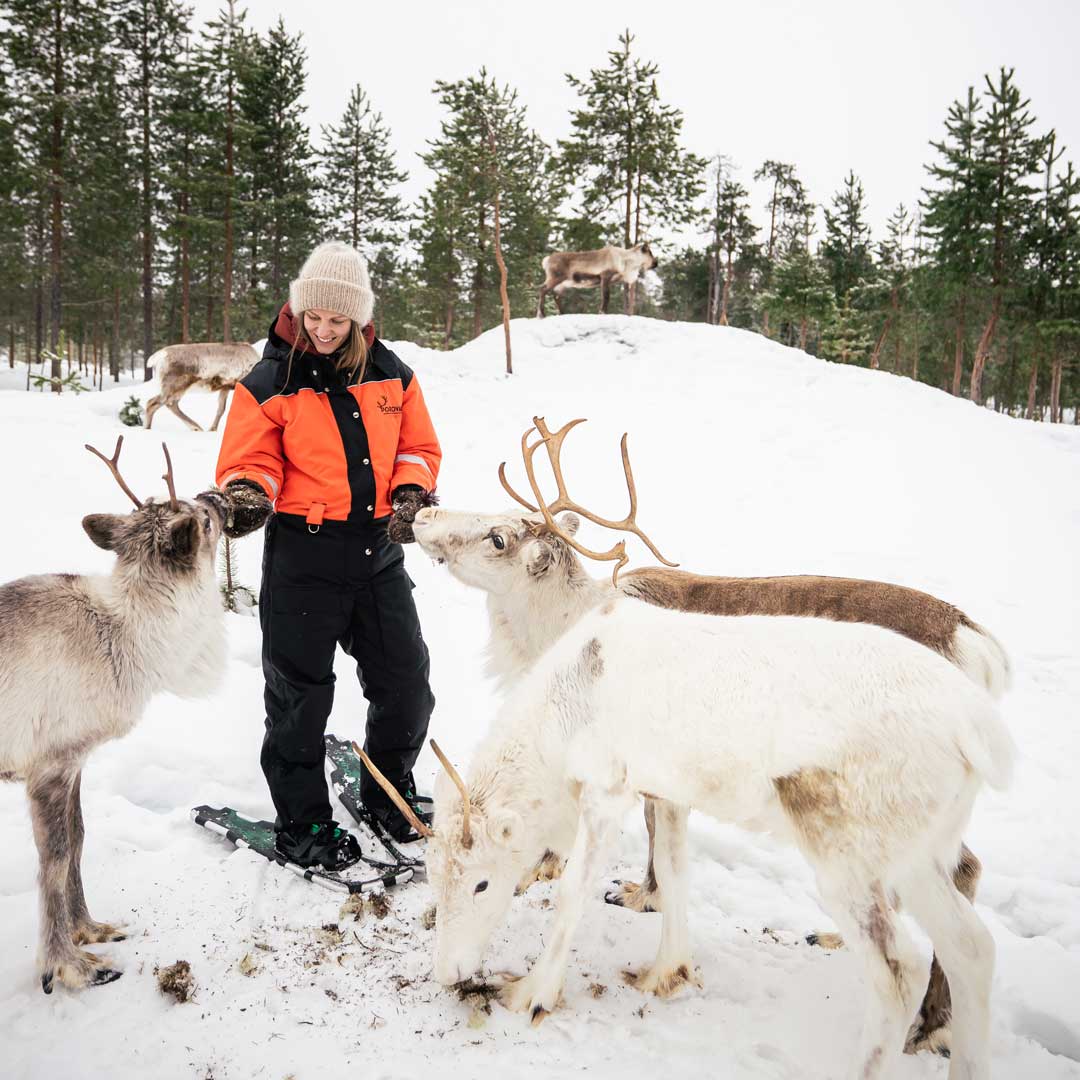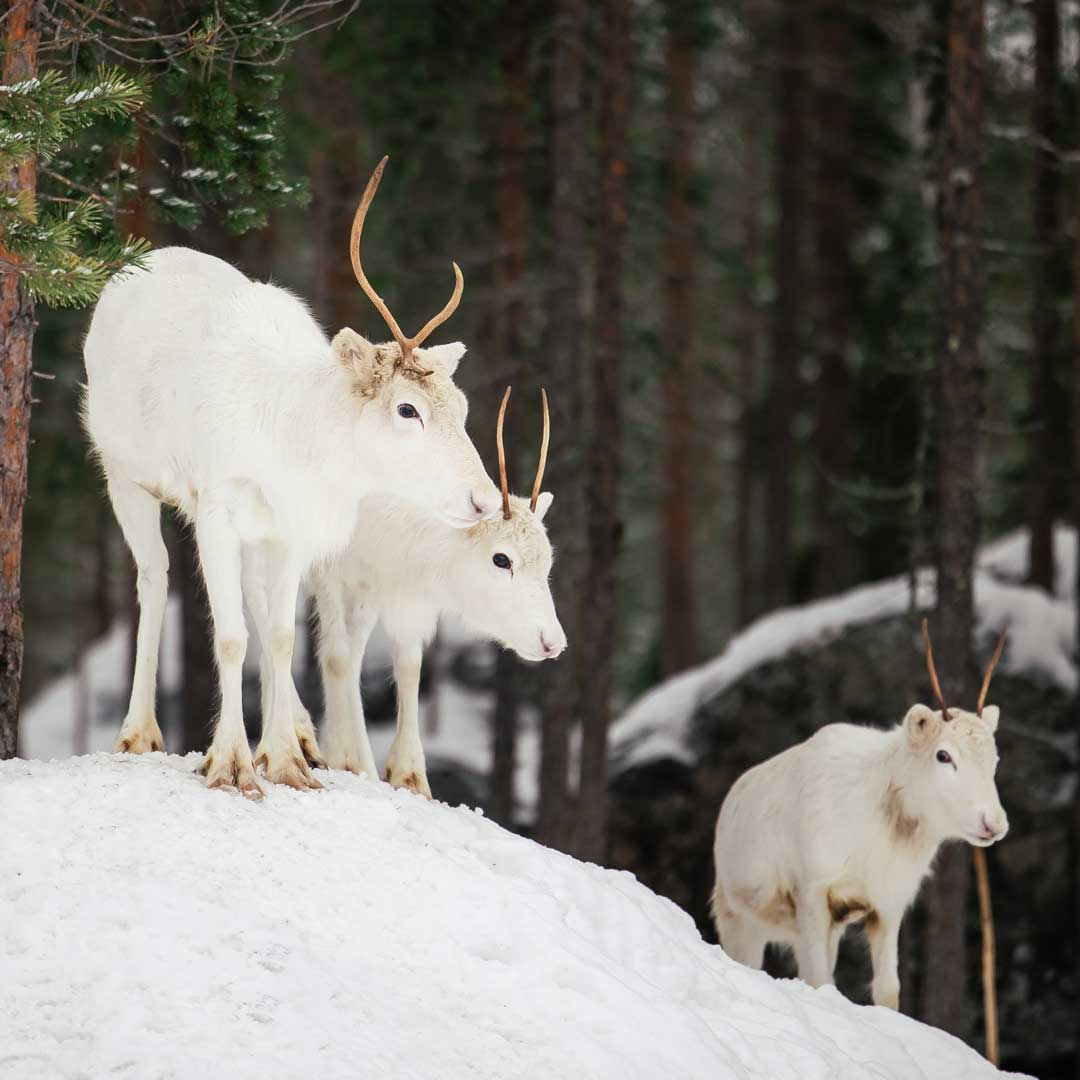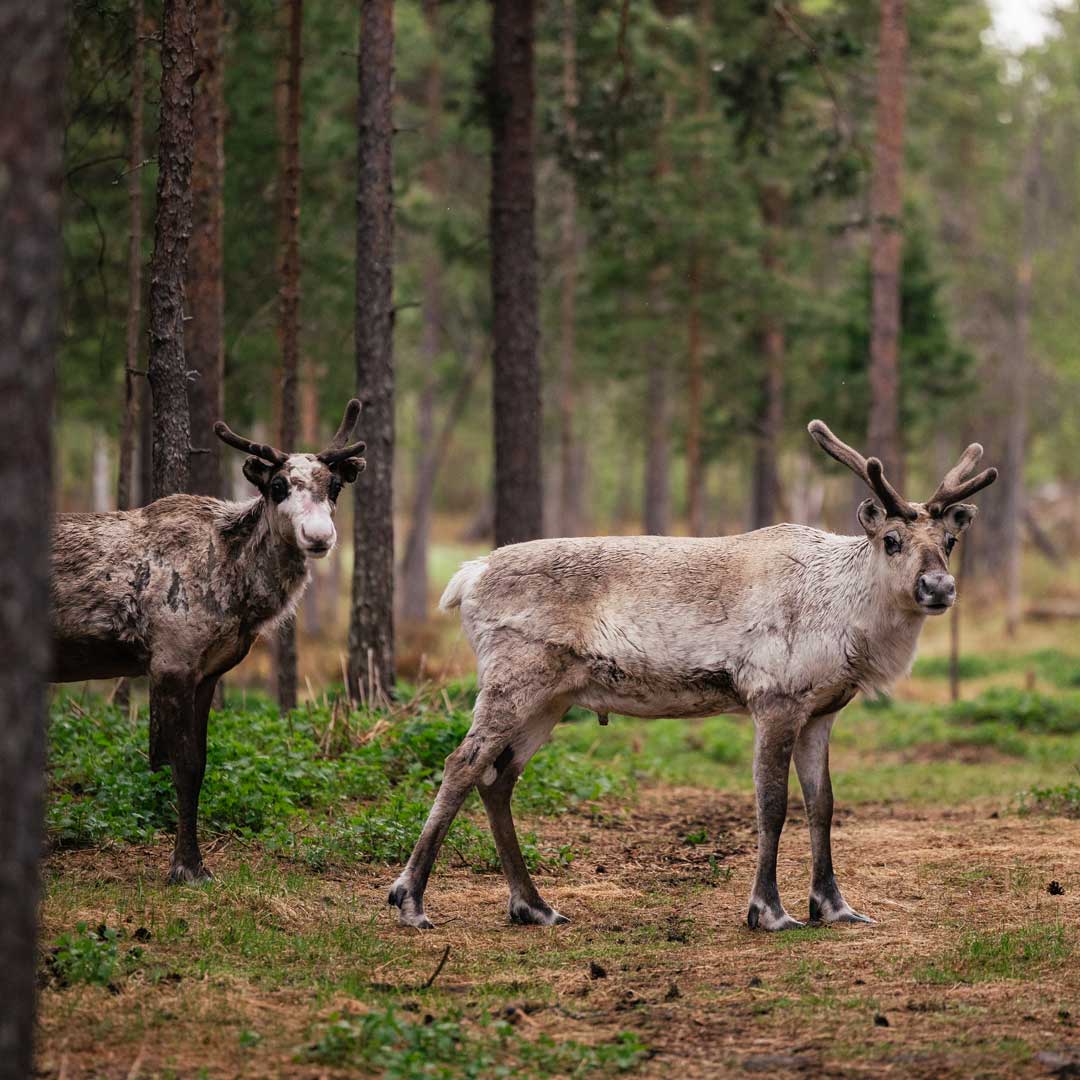Our Reindeer – Learn about reindeer in Finland
Reindeer are especially important to Santa Claus, as taking good care of them ensures that gifts can be delivered around the world every Christmas. Our family has been caring for reindeer for decades, and we are experts in understanding their well-being. This long tradition and experience help us keep our reindeer healthy and happy. Even though the busiest tourism season doesn’t last all year, caring for the animals is a year-round job that requires commitment and dedication.
The well-being of both people and animals is our top priority. When our reindeer and employees are well taken care of, we can offer unforgettable experiences to everyone who uses our services. Our employees are trained to share more information about our reindeer and their lives, and they are always ready to provide fascinating insights into these unique animals. If you want to learn more about reindeer in Finland, you have come to the right place.

Information on Reindeer in Lapland
Reindeer (rangifer tarandus tarandus) is a half-wild artiodactyl tamed from the mountain reindeer in the Late Middle Ages. Reindeer is rather small in size, but a strong and tough northern animal. Male reindeer, stag, weighs 90-180 kg and has a withers height of about 110 cm. The antlers of a stag can weigh up to 10 kg. A female reindeer, doe, is a bit smaller – it weighs 60-100 kg and has a withers height of about 90 cm. Doe’s antlers are small and light. The average life expectancy of a reindeer is 10-15 years, but they can live up to 20 years.
Reindeer’s nutrition varies based on the season: in the spring and in the summer the reindeer eat various grasses, hays, twigs, lichen, leaf buds and later tree and bush leaves. In the autumn the reindeer prepare for winter by eating mushrooms in addition to twigs, grasses and hays. In the winter, when the food is scarce, the reindeer look especially for lichen.
We Believe in Doing Things Right
Sustainability, animal welfare, and respect for nature are at the heart of what we do – not just in words, but in every decision we make.
How reindeer has adapted to Northern Circumstances
Hooves
Reindeer has multiple features perfectly fitting the northern conditions. One of these are the unique hooves that spread wide, which helps the reindeer to move in the deep snow and boggy swamps. With the hoof’s sharp edge reindeer can dig up food from even under the deep snow. The most important sense of a reindeer is a very good sense of smell, which helps the reindeer to find food throughout the year – they can even smell the lichen from under a meter of snow!


Fur
Another important feature is reindeer’s warm, thick fur. Reindeer fur is actually the second warmest in the world – only a polar bear’s fur is more insulating than the one of a reindeer! The speciality of a reindeer fur is that each hair is hollow, which creates insulating air pockets. The thick undercoat further enhances thermal insulation. Reindeer’s snout and feet are covered in hair as well, but the feet hair doesn’t provide protection against the cold like the other parts of the fur. However, due to their unique blood circulation system and oleic acid in the bone marrow the feet won’t freeze even in low temperatures.
In the summer the winter fur is naturally too hot for the reindeer, which is why they change into thinner summer fur.
Antlers
Summer is also an ideal time to start growing the new, yearly replaced set of antlers. Due to the shortness of the summer the antlers have to be grown quickly before autumn. Reindeer antler is actually the fastest growing bone in the world: it can grow up to 2 cm per day! During the growth the antler is covered in a protective skin, which makes it very sensitive. In autumn, when the antler is fully grown, the reindeer rubs the skin off and the antler becomes hard, numb and robust. The stags need the antlers for the rutting time fights, after which they drop them. The does use their antlers to protect their calves and the best feeding locations, and keep their antlers until late spring. Also the calves grow little antlers during their first summer.

Reindeer calf
The rutting time is in September and October. Doe pregnancy lasts 7 months, and each doe usually gives birth to one calf in May. The calf weighs 4-6 kg, but grows quickly due to fatty and nutritious milk of the dam. During the first weeks of its life the calf is protected by brown fat surrounding its intestines, which covers about 1-2% of the calf’s body weight. After the lactation finishes, the calf keeps growing due to the food multitude of the northern nature. The calf becomes independent at about one year old.

Reindeer Herding
Originally reindeer was tamed to produce milk and meat, to carry and pull heavy loads and as bait for hunting. In addition, reindeer provided materials for clothes and tools. Reindeer was an essential form of transportation in the northern wilderness; the traditional reindeer herding was done by moving with the reindeer from the summery mountain fields of the north to the southern forests for the winter. One way distance of these trips might have been as long as 400 km.
During centuries and due to the forming of the country borders and the development of technology the reindeer herding has developed to its current form: instead of traveling the reindeer are now herded with snowmobiles and GPS devices. The reindeer are nowadays increasingly used in providing tourism services, such as reindeer farm visits and reindeer sleigh rides. Reindeer meat is a popular Lappish delicacy, and reindeer bone, antler and leather are well-known handicraft materials in Lapland.
In the area of reindeer husbandry in Northern Finland there are approximately 200.000 reindeer moving around freely. However, each of the reindeer has an owner with an individual mark with which they mark all of their reindeer. The reindeer are gathered twice a year for a reindeer round-up. The round-ups are held in the midsummer and in the autumn, when the reindeer naturally gather together due to the great amount of mosquitoes and for the rutting season. During the round-up the reindeer are counted and medicated for parasites, the calves are marked by cutting the owner’s mark to their ears and the reindeer to be slaughtered are separated from the herd.
See and experience the life of a reindeer herder.